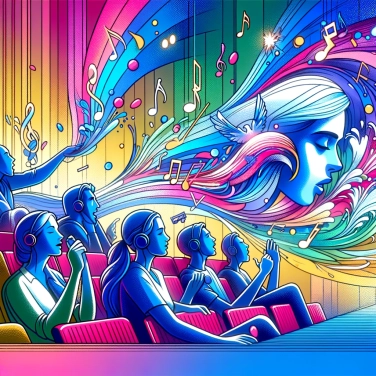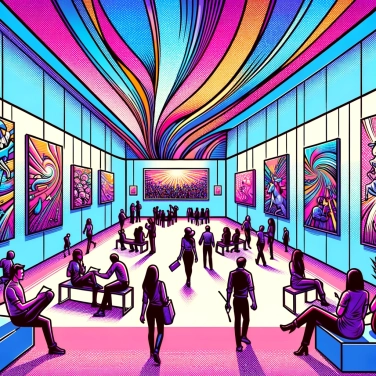Film soundtracks have a strong emotional impact on viewers because music can influence emotions by activating areas of the brain related to memory and feelings, thus enhancing the immersion and emotional experience of the film.

Our brain naturally associates sounds and images, and together, these two elements reinforce each other. A precise sound associated with a particular image can multiply the emotion felt: for example, a sad scene is even more poignant with a gentle melody that underscores the moment. Several senses stimulated at the same time create a powerful immersive experience for the viewer, who thus retains the scene better and may relive it mentally later. This sensory cooperation amplifies the overall perception of the sequence and helps to enter the film's universe more easily.
Our brain loves to associate sounds and memories. Listening to a soundtrack can provoke a genuine emotional reaction because it directly activates our memory and emotion areas. This is called a phenomenon of auditory association: hearing a piece of music linked to a significant moment in a film almost instantly transports us back to the state we were in then (suspense, sadness, joy). By continually associating a particular melody with a character or a significant moment in the storyline, the musical track ultimately becomes a true gateway to our sensory memory. A brief excerpt heard years later can awaken very specific images or emotions because our brain has unconsciously recorded this connection, as if the music serves as an emotional bookmark.
Music in films is often constructed as a sort of emotional journey parallel to the story: it guides our perception without us even noticing. Choices like rhythm, melody, or sound texture resonate directly with specific elements of the narrative. An action scene gains tension with nervous music; a romantic passage comes to life with a soft, almost intimate melody. Sometimes, even the sudden silence after an intense musical passage can evoke a shock or a feeling of emptiness intended by the director. The precise positioning of music also allows for the anticipation or highlighting of narrative twists, capturing the viewer's attention at key moments. We may not realize it in the moment, but it is this subtle construction that truly makes a film resonate with us.
When a particular melody recurs regularly throughout a film, it eventually becomes a sort of emotional signal for the viewer. This recurring musical theme is a powerful trick. As soon as we hear it, we instantly recall a situation, a character, or a specific emotion, like a kind of immediate auditory memory. Just think of some ultra-famous pieces: the theme from Harry Potter, the chilling notes from Jaws, or the heroic anthem of Star Wars. By repeatedly hearing these leitmotifs, the music acts somewhat like an emotional beacon: from the very first notes, it automatically puts you back in the mood, preparing you for the drama or the epic moment. This conscious repetition of sounds unconsciously reinforces our feelings, deeply anchors the narrative in our memories, and clearly amplifies the film experience.
We all grow up with certain movie soundtracks, which makes them deeply ingrained in us collectively. Soundtracks often become strong cultural references, like the Imperial March in Star Wars or the melody of Harry Potter. When we listen to these pieces again, they are immediately associated with a specific universe, an era, or memories shared by an entire generation. This common reference facilitates a form of collective identification and a sense of belonging: we recognize each other in these cult soundtracks. They then become a simple and powerful way to strengthen social and cultural ties.
Researchers have demonstrated that music can alter our perception of time. A film sequence without music often seems slower, while intense music gives us the feeling that the action is progressing more quickly.
In the famous film 'Inception', the recurring and mysterious melody titled 'Non, je ne regrette rien' by Édith Piaf is used as a leitmotif and is also slowed down to form the sound backdrop for the dream sequences. A subtle trick that enhances the emotional power of the story!
The phenomenon known as 'Mickey Mousing' refers to a musical technique that closely synchronizes the physical movements of characters with specific musical notes, thereby enhancing the comedic or dramatic emotions of the film.
The composer Hans Zimmer used the ticking of Christopher Nolan's watch as a rhythmic loop for the soundtrack of the film 'Interstellar', thereby enhancing the dramatic tension and the sense of urgency felt by the characters.
The original soundtrack serves to accompany the narrative emotion, rhythm the action, contextualize the story, highlight the dramatic stakes, and reinforce the identity of the cinematic work for the audience.
Yes, they employ various musical techniques, such as the precise selection of tonalities, specific instruments, and particular harmonies that evoke specific emotions (tension, nostalgia, happiness). They also play with rhythm and the repetition of melodic themes to subtly influence the emotional states of the audience.
Music allows the audience to directly feel what a character is experiencing by translating their emotional states through carefully chosen sounds and melodies. This creates a deep connection between the viewer and the story being told, strengthening attachment and empathy towards the characters.
Silence is a crucial element, as it enhances the emotional impact of the sounds and music that follow. It also provides a space for introspection for the viewer, heightening the narrative tension and adding more dramatic weight to certain important scenes.
Film music often triggers strong emotions and becomes ingrained in our emotional memory. When associated with impactful scenes, the brain more easily retains these auditory memories, allowing for lasting and intense recollection.

No one has answered this quiz yet, be the first!' :-)
Question 1/5